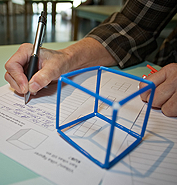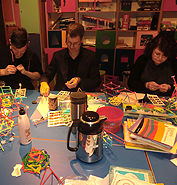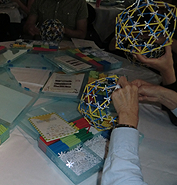Curriculum and 4DFrame
Like for any teacher around the world, a classroom aide is most helpful when it can
be used in conjunction with the approved curriculum for the subject being taught.
Educators for all grade levels ask if 4DFrame can find a place in such activity,
and the answer is yes! The following is a list of various subjects covered in the
Swedish curriculum for primary school grades 1 through 9 and how 4DFrame can contribute
to your students’ education.
Grades 1 to 3...
Grades 4 to 6...
Grades 7 to 9
A new teaching material
4DFrame is a new and innovative teaching aid based on simple elements (tubes and
connectors) that can be used to create patterns, shapes and forms. It has been used
with great success in Korea for about 10 years and has recently been introduced in
Sweden. Those schools that have been using it here for about one year's time report
that the material is highly appreciated and that children learn a lot through using
it. 4DFrame is a concrete material that develops imagination and creativity. The
whole time a person uses it they are developing both hand and fine motor skills and
they see the result of their work directly. Spatial thinking is stimulated and the
forms are developed into interesting objects. Innovation and design are central to
the work of 4DFrame and the material has been praised by artists, architects, teachers
and engineers. Several reports have been presented, including one by Professor Alla
Ericson of Södertörn University, Sweden. All such studies indicate that the material
has a positive impact on learning, particularly in geometry and spatial thinking.
A variety of science centers have used this material in different contexts and for
students at different grade levels. We are now working to create a network of groups
in different cities in primary and secondary education. For the most effective use
of 4DFrame as a creative teaching material, it is important that 4DFrame be introduced
to the youngest students and then follow through with them during the years afterward.
Such continuous work and familiarity with 4DFrame leads to more creative learning
opportunities.
Here are some examples of how 4DFrame can be presented in primary school grades 1
– 9.
4DFrame for children in primary grades 1 - 3
4DFrame stimulates an interest in patterns, colors and shapes in children. Its different
colored tubes and the white connectors are used to make the patterns and shapes that
are then used to continue to emphasize the different areas of pictures, technology,
and mathematics. Colors and shapes in nature and the environment are starting points.
It also brings to the students’ attention the aesthetic values between mathematical
patterns and shapes. Lines, points, geometry, surface and volume are central concepts.
The following meets these curriculum objectives in 2011:
Art:
- Create images using digital and artistic tools and techniques, and with different
materials.
- Explore and present different topics with images.
Mathematics:
- How simple patterns found in number sequences and simple geometric patterns can
be constructed, described and expressed.
- Basic geometric objects such as points, lines, segments, quadrilaterals, triangles,
circles, spheres, cones, cylinders and cuboids and their mutual relationships. Describe
the basic geometric properties of these objects.
- Construction of geometric objects. Scaling for simple enlarging and shrinking.
- Common expressions used to describe objects and their position in space.
- Symmetry, for example, as found in pictures and in nature.
- Different proportional relationships, including half and double.
- Mathematical formulation of questions from simple everyday situations.
Swedish:
- Listening and retelling in various conversational situations.
- Oral presentations and storytelling about everyday topics for different audiences.
How photos and other aids can be used to support presentations.
- Words and concepts that are used to express feelings, opinions and knowledge.
Technology:
- Materials for your own design work, their properties and how they can be joined
together.
- A few simple words and terms used to name and discuss technical solutions.
Working methods for the development of technical solutions:
- Custom designs through applying simple mechanisms.
- Documentation in the form of simple sketches, pictures and physical models.
Top of page
4DFrame for children in primary grades 4-6
Using 4DFrame stimulates interest in design and construction. You can use the material
to easily make sketches in 3D. Sketches and finished designs, strength and function
are themes to be explored. Make sure to investigate how buildings, towers and bridges
are designed and built in your neighborhood. Emphasize the roles of architects and
engineers in this context. Now try to build with structures with 4DFrame that lead
to stable models. Parallels are drawn to the bridges and similar structures encountered
in everyday life.
The program provides students the opportunity to develop their creativity and their
interest in technology and to create. It also builds on investigating and resolving
problems and seeking innovative solutions. Elements of the program are technology,
historical perspectives on architecture, and technical expertise.
The following meets these curriculum objectives in 2011:
Art:
- Drawing, painting, printing and three-dimensional work.
- Tools for three-dimensional work and how they are referred to.
- Flat and ductile materials and how these can be used in various art applications.
- Art-, documentary photography and architectural works from different periods and
cultures, how they are designed, and what messages they convey.
Mathematics:
- Assessing the plausibility of estimates and calculations in everyday situations.
- How patterns found in numerical sequences and geometric patterns can be constructed,
described and expressed.
- Basic geometric objects such as polygons, circles, spheres, cones, cylinders, pyramids
and cuboids and their mutual relationships. Describe the basic geometric properties
of these objects.
- Construction of geometric objects. Scale and its use as found in everyday situations.
- Symmetry in everyday life, in art and in nature, and how symmetry can be constructed.
- Comparison, estimation and measurement of length, area, volume, mass, time and
angles with standard units of measure. Measurements made by using modern and traditional
methods.
Swedish:
- Oral presentations and storytelling for different audiences on topics taken from
everyday life and school. The usage of key words, images and digital media as a tool
for planning and conducting an oral presentation. How gestures and body language
can affect your presentation.
History:
- Examples of how antiquity, the Middle Ages, 1500s, 1600s and 1700s can be seen
in modern times through traditions, names, linguistic expressions, buildings, cities
and boundaries.
Technology:
- Everyday objects consisting of moving parts and how these moving parts are joined
together by using a variety of mechanisms for transferring and enhancing forces.
- How common solid and stable structures, such as buildings and bridges, are built.
- Common materials, such as wood, glass and concrete, and their properties and use
in solid and stable structures.
- Words and concepts used to name and discuss technical solutions.
- Custom designs with applications of principles of solid and stable structures,
mechanisms and electrical connections.
- Documentation in the form of sketches with explanatory words and concepts, symbols
and dimensions as well as physical or digital models.
- Impact of technology choices, such as the pros and cons of different technical
solutions.
Top of page
4DFrame for children in primary grades 7 - 9
4DFrame can be used for shaping ideas about the future of society and sustainable
technological development. The work is preceded by group discussions about the needs
for sustainable technologies and resource conservation efforts by the community and
the environment.
Students are asked to:
Construct a (model of) a machine, a product, or a tool that helps us in improving
the environment in the future.
Students work together in groups (preferably with three people in each group) and
begin with:
1) Summarizing their ideas in a simple sketch.
2) Build a model.
3) Write a simple description of the model.
4) Present the 3D model to the other groups in the class.
5) Answer questions about their creations.
The purpose of the task is to help students develop interest in technology and the
ability to take on technical challenges in an informed and innovative way, and to
find out how we can - in various ways and with different methods - help to achieve
a sustainable society. We want to convey the notion that every effort makes a difference
and we all can contribute to change.
The following meets these curriculum objectives in 2011:
Art:
- Production of narrative and informative social studies-oriented pictures of their
own competence, opinions and experiences.
- Materials and tools for two-and three-dimensional work and how they can be used
for specific purposes.
- Words and concepts to be able to read, write, and converse on a picture's design
and message.
Mathematics:
- Assessing the plausibility of estimates and calculations in both everyday and mathematical
situations as well as in other fields.
- Geometric objects and their inter-relationships. Describe the geometric properties
of these objects.
- Depiction and construction of geometric objects. Scaling with the reduction and
enlargement of two-and three-dimensional objects.
- Methods for calculating the area, perimeter and volume of geometric objects, and
parts replacement as used in this context.
- Uniform probability and methods for calculating probability in everyday situations.
Nature and Society:
- Human impact on the environment locally and globally. What are our possibilities
as consumers and citizens to contribute to sustainable development.
- Forces, movements and changes in motion in everyday situations and how this knowledge
can be used, for example, in matters of road safety.
- Levers and exchange in tools, such as scissors, skewers, block and tackle.
- How sound is created, spread and, may be recorded in different ways. The characteristics
of sound, the sound environment, and the effects it has on our health.
Physics' methods and mode of operation:
- Systematic surveys. The formulation of simple issues: planning, execution, and
evaluation.
- Measuring, instruments of measurement, and how they can be combined to measure
quantities, such as speed, pressure and power.
- The relationship between physical investigation and the development of concepts,
models and theories.
Habitats:
- Climate change, various explanations for this, and what impact such changes may
have on people, society and the environment in different parts of the world.
Swedish:
- Different ways to work with the student’s own texts in form and content. How to
give and receive constructive feedback about texts one has written or read.
Speaking, listening and conversing:
- To lead a conversation, formulate and respond to arguments, and summarize the main
features of what has been said.
Technology:
- Technical solutions for solid and stable structures, such as steel rebar and beam
shapes.
- Importance of properties, such as tensile and compressive strength, hardness and
elasticity of materials selected for engineering solutions. The properties and application
various new materials used in such solutions.
- Words and concepts to refer to and discuss in technical solutions.
- The different phases of technological development: identification of needs, investigation
and proposal of solutions, construction and testing. How phases of the work process
come together.
- Documentation in the form of manual and digital sketches and drawings, with explanatory
words and concepts, symbols and dimensions, as well as documentation with physical
or digital models. How simple written reports can be used to describe and summarize
the construction and technical development during a project.
- Relationship between technological development and scientific progress. How technology
has enabled scientific discovery and how science has enabled technical innovation.
- Recycling and the reuse of materials for various manufacturing processes. How technological
solutions can contribute to sustainable development.
- Impact of technology choices based on ecological, economic, ethical and social
aspects, such as in the development and use of biofuels and military ordnance.
Top of page
©2013-2018, Nordic4DFrame AB
Grönviksvägen 6, 185 41 Vaxholm, Sweden




